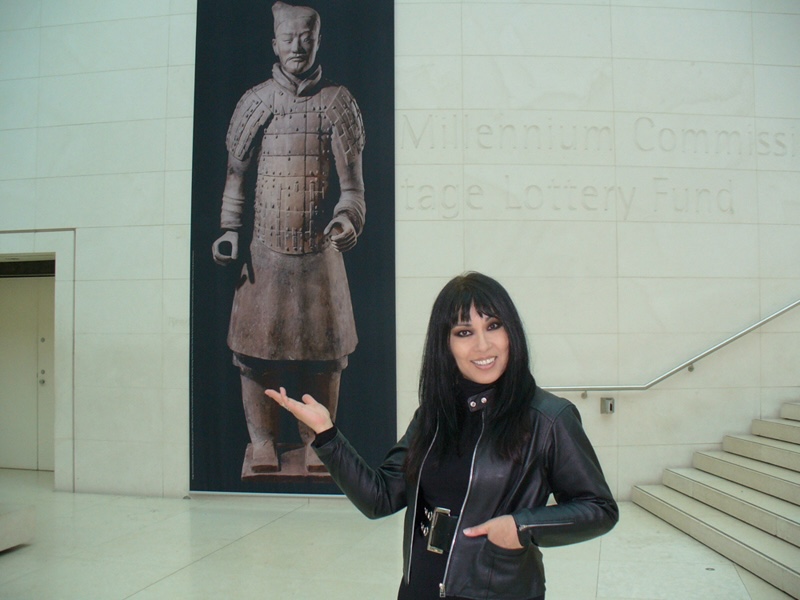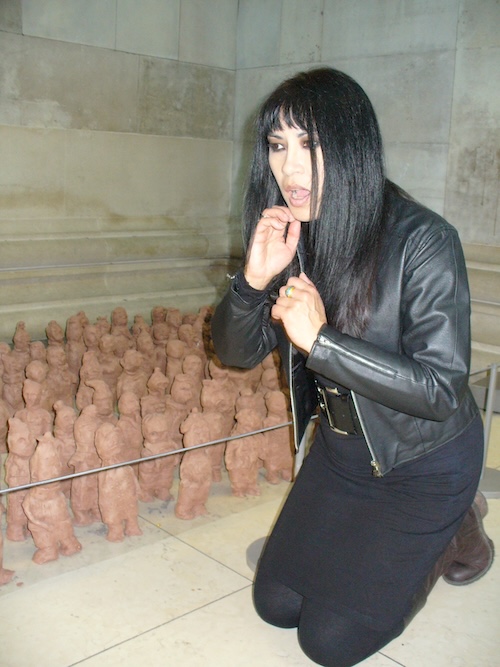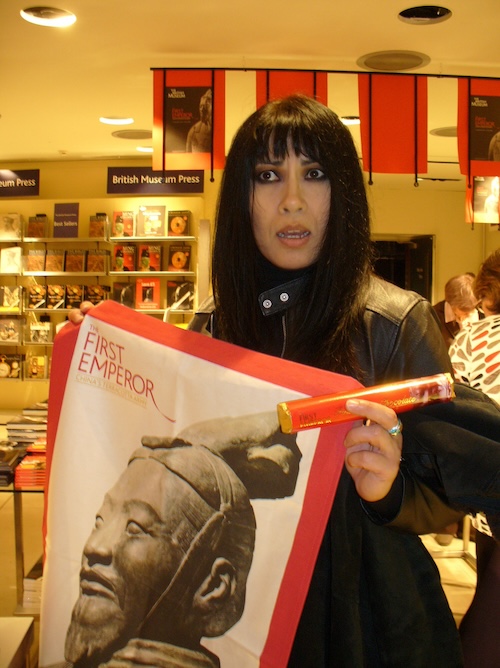Anna Chen – 25 June 2008, Terracotta Warriors

I was so looking forward to being Flavour Of The Month at home in Old Blighty for a moment or three, what with the excitement of the Beijing Olympics in August. But due to certain events at the roof of the world, any profile I might have enjoyed has been relegated to somewhere between Empress Ming The Merciless and the Evil Daughter of Fu Manchu. Here I am, plonked in the middle of a three-minute hate where someone’s lost the stopwatch. Less Anna the Honey and more Atilla the Hun.
Still, that’s showbiz. On with the show …
I caught the first and biggest of the UK China-themed events, the Terracotta Warriors at the British Museum, which drew to a close in April (Stop the presses!) having played to packed audiences. Which is understandable, because an hour after you’ve seen it, you want to go round again.
This being the adoptive home of the Elgin Marbles, the looted treasures of the pyramids, and assorted plunder from around the globe, it never was going to be a simple task for the curators. Unable to make up their minds whether the First Emperor Qin Shi Huangdi was the heroic uniter of the seven warring kingdoms or one of the biggest baddies the ancient world had ever seen, the narrative of the display resembled a wolf caught in a trap, chewing off its own foot with the madness of its own contradictions.
But I enjoyed it. It was a good-looking beast, lit and designed by artists in the world famous Reading Room where Marx, Lenin and Orwell once studied and changed the world, though only Gandhi rated a biopic.
As an added bonus we sat in the Great Court cafe, afterwards, watching dusk fall, with an intrepid mouse foraging food off the floor around us. A magic moment.

The First Emperor, who united China in 221 BC, is said to have loved war. He said the only way to make everyone else enjoy his hobby was to make peacetime so horrible that they welcomed a bit of rape, pillage and bloodshed just for the relief. On the other hand, he did standardise measurements, weights, money, laws, taxes and much else that nailed this longest lived empire into place.
But his namesake of 2,500 years ago, the Yellow Emperor, also known as Huangdi, loved life. He was the Sting of his day, a practitioner of tantric sex, feeding off female energy, believing it would help grant him longevity. How sad that women never loomed as large in the First Emperor’s sex-life as they did in the Yellow Emperor’s. Women figured not at all in his after-life fantasy world according to the artefacts on show. There were soldiers, acrobats, musicians, civil servants and stable boys, but not a single female in sight.
Chinese women — invisible even in ancient China.


The First Emperor Exhibition at the British Museum, 13 September 2007 to 6 April 2008
Ancient China chronology (from the First Emperor exhibition book, Editor Jane Portal):
2697 BC Mythical reign of the Yellow Emperor
2500 BC Jade artefact production
2000 BC Bronze-casting technology developed
1600 BC (previously 1766 BC) Beginning of the Shang dynasty
1700 BC Earliest known bronze ritual vessels
1500 BC first glaze used on ceramics
1350 BC earliest surviving Chinese writing found on oracle bones
1050 BC The Western Zhou dynasty begins
770-221 BC The Eastern Zhou dynasty
697-678 BC Duke Wu of Qin
604 BC Laozi, founder of Daoism, is born
551 BC Confucius is born (551-479 BC)
475 BC The Warring States period of the Easten Zhou dynasty begins
384-362 BC The reign of Duke Xian of Qin
372 BC Mencius is born
361-338 BC Reign of Duke Xiao of Qin
356 BC Legalist reforms in military and political affairs by Shang Yang empower Qin
325 BC First time title of “king” is adopted – King Huiwen of Qin
316 BC The state of Qin conquers Shu state
286 BC Qin conquers Song
259 BC Birth of Ying Zheng who will become Qin Shihuangdi, the First Emperor or huanghdi
256 BC Qin conquers Zhou
246 BC Ying Zheng becomes King of Qin at 13
230-225 BC Qin conquers the states of Han, Zhao and Wei
223 BC Qin conquers Chu
221 BC Qin conquers Qi and begins the Qin dynasty
215 BC Construction begins on the Great Wall
210 BC Qin Shihuangdi dies aged 49 and is entombed near Xian. His terracotta army is buried 1.5km to the east.
206 BC The Qin dynasty ends after only 15 years. The Western Han dynasty begins.
